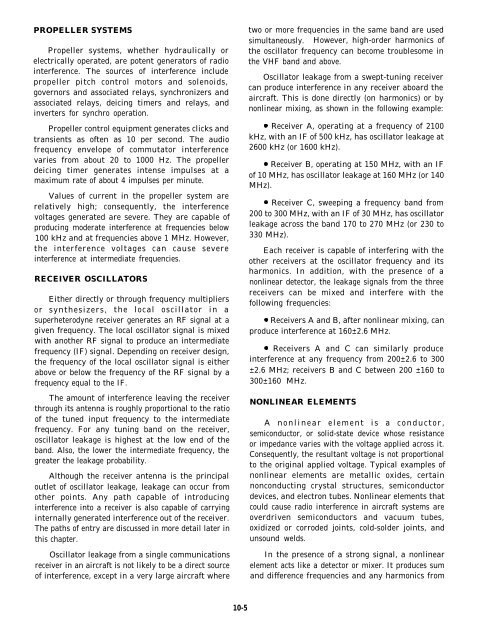Aviation Electronics Technician 1 - Historic Naval Ships Association
Aviation Electronics Technician 1 - Historic Naval Ships Association
Aviation Electronics Technician 1 - Historic Naval Ships Association
Create successful ePaper yourself
Turn your PDF publications into a flip-book with our unique Google optimized e-Paper software.
PROPELLER SYSTEMSPropeller systems, whether hydraulically orelectrically operated, are potent generators of radiointerference. The sources of interference includepropeller pitch control motors and solenoids,governors and associated relays, synchronizers andassociated relays, deicing timers and relays, andinverters for synchro operation.Propeller control equipment generates clicks andtransients as often as 10 per second. The audiofrequency envelope of commutator interferencevaries from about 20 to 1000 Hz. The propellerdeicing timer generates intense impulses at amaximum rate of about 4 impulses per minute.Values of current in the propeller system arerelatively high; consequently, the interferencevoltages generated are severe. They are capable ofproducing moderate interference at frequencies below100 kHz and at frequencies above 1 MHz. However,the interference voltages can cause severeinterference at intermediate frequencies.RECEIVER OSCILLATORSEither directly or through frequency multipliersor synthesizers, the local oscillator in asuperheterodyne receiver generates an RF signal at agiven frequency. The local oscillator signal is mixedwith another RF signal to produce an intermediatefrequency (IF) signal. Depending on receiver design,the frequency of the local oscillator signal is eitherabove or below the frequency of the RF signal by afrequency equal to the IF.The amount of interference leaving the receiverthrough its antenna is roughly proportional to the ratioof the tuned input frequency to the intermediatefrequency. For any tuning band on the receiver,oscillator leakage is highest at the low end of theband. Also, the lower the intermediate frequency, thegreater the leakage probability.Although the receiver antenna is the principaloutlet of oscillator leakage, leakage can occur fromother points. Any path capable of introducinginterference into a receiver is also capable of carryinginternally generated interference out of the receiver.The paths of entry are discussed in more detail later inthis chapter.Oscillator leakage from a single communicationsreceiver in an aircraft is not likely to be a direct sourceof interference, except in a very large aircraft wheretwo or more frequencies in the same band are usedsimultaneously. However, high-order harmonics ofthe oscillator frequency can become troublesome inthe VHF band and above.Oscillator leakage from a swept-tuning receivercan produce interference in any receiver aboard theaircraft. This is done directly (on harmonics) or bynonlinear mixing, as shown in the following example:. Receiver A, operating at a frequency of 2100kHz, with an IF of 500 kHz, has oscillator leakage at2600 kHz (or 1600 kHz).. Receiver B, operating at 150 MHz, with an IFof 10 MHz, has oscillator leakage at 160 MHz (or 140MHz).. Receiver C, sweeping a frequency band from200 to 300 MHz, with an IF of 30 MHz, has oscillatorleakage across the band 170 to 270 MHz (or 230 to330 MHz).Each receiver is capable of interfering with theother receivers at the oscillator frequency and itsharmonics. In addition, with the presence of anonlinear detector, the leakage signals from the threereceivers can be mixed and interfere with thefollowing frequencies:l Receivers A and B, after nonlinear mixing, canproduce interference at 160±2.6 MHz.. Receivers A and C can similarly produceinterference at any frequency from 200±2.6 to 300±2.6 MHz; receivers B and C between 200 ±160 to300±160 MHz.NONLINEAR ELEMENTSA nonlinear element is a conductor,semiconductor, or solid-state device whose resistanceor impedance varies with the voltage applied across it.Consequently, the resultant voltage is not proportionalto the original applied voltage. Typical examples ofnonlinear elements are metallic oxides, certainnonconducting crystal structures, semiconductordevices, and electron tubes. Nonlinear elements thatcould cause radio interference in aircraft systems areoverdriven semiconductors and vacuum tubes,oxidized or corroded joints, cold-solder joints, andunsound welds.In the presence of a strong signal, a nonlinearelement acts like a detector or mixer. It produces sumand difference frequencies and any harmonics from10-5
















